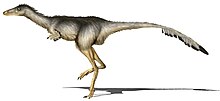| Albertonykus Temporal range: Late Cretaceous,
| |
|---|---|

| |
| Life restoration | |
| Scientific classification | |
| Domain: | Eukaryota |
| Kingdom: | Animalia |
| Phylum: | Chordata |
| Clade: | Dinosauria |
| Clade: | Saurischia |
| Clade: | Theropoda |
| Family: | †Alvarezsauridae |
| Genus: | †Albertonykus Longrich & Currie, 2009 |
| Species: | †A. borealis
|
| Binomial name | |
| †Albertonykus borealis Longrich & Currie, 2009
| |
Albertonykus (meaning "Alberta claw") is an alvarezsaurid dinosaur from the Maastrichtian-age (Upper Cretaceous) rocks of the Horseshoe Canyon Formation of Alberta, Canada. It is known from forelimb and hindlimb remains from multiple individuals. All but two of the specimens come from a bonebed dominated by Albertosaurus, located at the top of Unit 4 of the Horseshoe Canyon Formation,[1] dating to ~68.5 million years ago.[2]
Albertonykus is interpreted as having fed on wood-nesting termites because the forelimbs appear specialized for digging, but are too short for burrowing. Albertonykus is the earliest-known North American alvarezsaurid. Isolated bones of alvarezsaurids are known from late Maastrichtian rocks in Montana and Wyoming (USA). The bones now belonged to a new genus, Trierarchuncus.[3][4]
The type species is A. borealis, described by Nick Longrich and Philip Currie in 2009. The specific name (borealis) means "north".[5]
- ^ Larson, D. W., Brinkman, D. B., & Bell, P. R. (2010). Faunal assemblages from the upper Horseshoe Canyon Formation, an early Maastrichtian cool-climate assemblage from Alberta, with special reference to the Albertosaurus sarcophagus bonebed This article is one of a series of papers published in this Special Issue on the theme Albertosaurus. Canadian Journal of Earth Sciences, 47(9), 1159-1181.
- ^ Arbour, Victoria (2010). "A Cretaceous armoury: Multiple ankylosaurid taxa in the Late Cretaceous of Alberta, Canada and Montana, USA". Journal of Vertebrate Paleontology. 30 (Supplement 2): 55A. doi:10.1080/02724634.2010.10411819.
- ^ Denver W. Fowler; John P. Wilson; Elizabeth A. Freedman Fowler; Christopher R. Noto; Daniel Anduza; John R. Horner (2020). "Trierarchuncus prairiensis gen. et sp. nov., the last alvarezsaurid: Hell Creek Formation (uppermost Maastrichtian), Montana". Cretaceous Research. 116: Article 104560. doi:10.1016/j.cretres.2020.104560. S2CID 225630913.
- ^ "Badlands - Research - 2020 new alvarezsaurid species". Dickinson Museum Center. Retrieved 2020-07-17.
- ^ Longrich, Nicholas R.; Currie, Philip J. (2009). "Albertonykus borealis, a new alvarezsaur (Dinosauria: Theropoda) from the Early Maastrichtian of Alberta, Canada: Implications for the systematics and ecology of the Alvarezsauridae". Cretaceous Research. 30 (1): 239–252. doi:10.1016/j.cretres.2008.07.005.